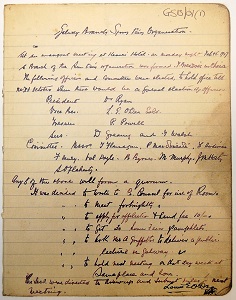MINUTES OF AN HISTORIC MEETING

by Tom Kenny
Our illustration today is of the minutes of the inaugural meeting of the Galway City Branch of Sinn Féin which was held in Keane’s Hotel, Eyre Square on February 15th, 1907. T Breathnach was in the chair.
''The following officers and committee were elected to hold office until next October when there would be a general election of officers.
President, Dr. Ryan ; Vice-president, Louis O’Dea, solicitor;
Treasurer, P. Powell ; Secretaries, D. Greany and T. Walsh.
Committee; Messsrs. T. Flanagan, P. Mac Donnchadha , F. Hardiman, F. Heary . Val Doyle, B. Byrnes, M. Murphy, John Hosty, S. O’Flaherty.
Any 5 of the above will form a quorum.
It was decided to write to the Co. Council for the use of rooms. ; to meet fortnightly ; to apply for affiliation and send fee of 10/- ; to get 30 Sinn Féin pamphlets ; to book Mr. A. Griffiths to deliver a public lecture in Galway ; to hold next meeting on that day week at same place and hour. The secretaries were directed to draw up and submit rules to the next meeting.. Signed Louis E. O’Dea”.
The illustration is shown courtesy of Galway County Council archives. Louis O’Dea was a local solicitor and coroner. T. Breathnach was Tom Walsh, a professor of Pathology in UCG who was largely responsible for “Converting UCG into a hot-bed of Sinn Féinism”. John Hosty was a Shantalla man who was sent by the Volunteers on Easter Saturday 1916 to check if there was to be a Rising or not.
This simple but important document is just one of the hundreds of illustrations in a new publication titled “Atlas of the Irish Revolution” edited by John Crowley, Donal Ó Drisceoil and Mike Murphy and published by Cork University Press. It is the most important and comprehensive publication ever produced on the period 1912 – 1923. In addition to the illustrations, many of which are reproductions of rarely seen documents, it includes over 300 original maps and more than 140 contributions from leading scholars across a range of disciplines.
The Atlas is accessible, readable and brilliantly produced , it has wide appeal to a specialist and to popular readership. Few readers will finish this book without fresh understanding of the forces that shaped modern Irelsnd. From a Galway point of view, there are some fascinating maps, photographs and contributions included. It is a big volume of almost 1,000 pages. It is THE reference book. In good bookshops, very highly recommended.
